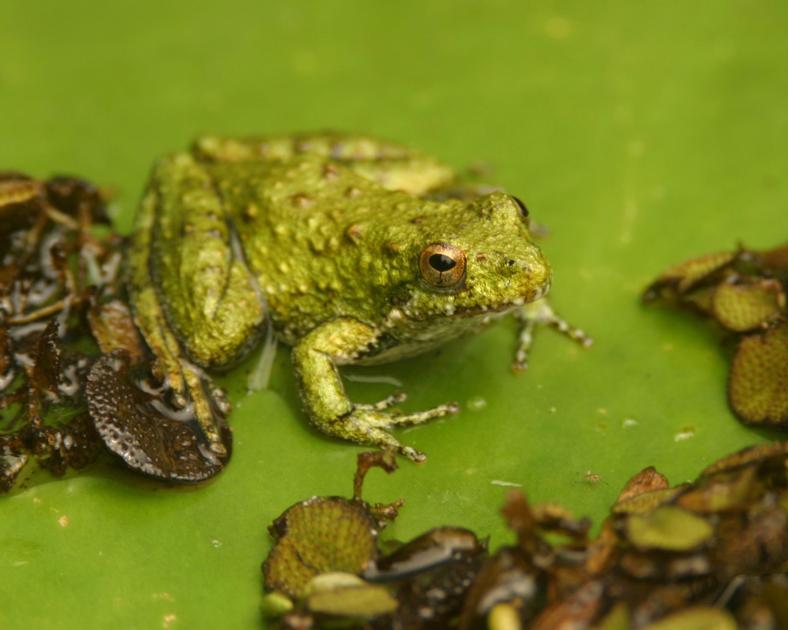
Whether it’s the deep “jug o’ rum” of the American bullfrog, the “peep, peep, peep” of the spring peeper or the “gick, gick, gick” of the northern cricket frog, give a listen and you'll hear nature’s chorus.
Green and slippery or brown and bumpy, frogs and toads are some of the first wild creatures we discover as kids.
For scientists, however, these amphibians are important indicators of our environmental health.
Frogs have lungs but can also breathe through their skin, making them sensitive to the presence of dangerous chemicals.
“They are biological indicators because they use water and land for their life stages and are easily affected by pollution,” said Darcy Tatsh, who leads the local FrogWatch USA.
FrogWatch, sponsored by the Association of Zoos & Aquariums, lets anyone become a citizen-scientist that can help researchers keep an eye on these harbingers of our environment.
Tatsch, who is the FrogWatch coordinator at BREC’s Baton Rouge Zoo, teaches volunteers about the 25 frog species specific to Louisiana. With classes on hold at least until January because of the coronavirus, online training ($15) is available at elearning.aza.org/products/4005/frogwatch-usa-volunteer-training.
For information on the Baton Rouge program, email Tatsch at dtatsch@brzoo.org or visit brzoo.org/education/learn-at-the-zoo/frogwatch.
Through the program, frog watchers can submit their observations to a national online database. Over 20 years of data has been collected through the FrogWatch program, providing valuable information to scientists.
Calls are one way to identify frogs and toad. If you want to hear what these creatures in Louisiana sound like, visit aza.org/louisiana.
Frogs live both on land and in water, usually near marshes, streams, ditches and ponds. Typically, toads have warty skin and short legs, whereas frogs usually have smooth skin and long legs. Many species have variations that could place them in either family.
“Frogs and toads are crucial in an ecosystem," Tatsch said. "As predators, they eat pests like mosquito larvae, and they serve as food for other creatures, like snakes and turtles. Some toxins they emit have been used in medicines and they are used for education and research purposes.”
Populations of amphibians worldwide have declined in past decades, largely due to habitat loss or development.
Invasive species are another threat to the frog and toad population.
In Louisiana, the Cuban treefrog, which already has invaded Florida, is becoming a threat to smaller native frogs, threatening species loss.
“They have noxious skin secretions, lay their eggs in birdbaths and fish ponds, and they can clog plumbing and cause power outages by short-circuiting utility switches where they seek refuge,” said Brad Glorioso, a research ecologist with the U.S. Geological Survey’s Wetland and Aquatic Research Center in Lafayette.
He said in 2016, a large population of the frogs were found in the area of the Audubon Zoo in New Orleans, probably brought there with palm trees purchased from Florida, and a second established population has been found St. Rose.
"And we constantly see waifs pop up, usually associated with horticultural businesses," Glorioso said.
Learn more about these frogs at louisianaherps.com/cuban-treefrog---osteopilus.html.
If you think you've found a Cuban treefrog, take a photo and include a description and send it, along with the location of where it was found, to Glororsio at gloriosob429@gmail.com.
These resources can help you learn more about local frogs and toads:
- “Peterson Field Guide to Reptiles and Amphibians of Eastern and Central North America,” third or fourth edition, by Roger Conant
- “Amphibians and Reptiles of Louisiana: An Identification and Reference Guide” by Jeff Boundy and John L. Carr
Louisiana Master Naturalists of Greater Baton Rouge seek to advance awareness, understanding and stewardship of the natural environment. For information, visit lmngbr.org.
Frog houses
Adding a frog house to your yard is a simple way to attract frogs and toads, who will devour mosquitoes, biting flies and plant predators.
For toads: Nestle an unglazed terra-cotta pot in damp soil in your flowerbed.
For treefrogs: Cut one end of a 2- to 3-foot PVC pipe (1.25-inch diameter) at a 45-degree slant, and, with a rubber mallet, hammer it into the ground near tall plants until it stands on its own. Put a little water inside. You can paint or decorate the pipe with permanent markers or paint pens (don't decorate the inside to protect the frogs from potentially toxic materials).
"hear" - Google News
July 06, 2020 at 11:00PM
https://ift.tt/2ZGQSoQ
Hear that? Frogs are calling and they need you to listen - The Advocate
"hear" - Google News
https://ift.tt/2KTiH6k
https://ift.tt/2Wh3f9n
Bagikan Berita Ini















0 Response to "Hear that? Frogs are calling and they need you to listen - The Advocate"
Post a Comment